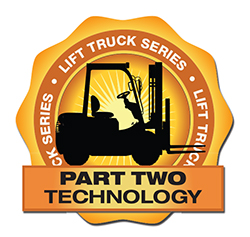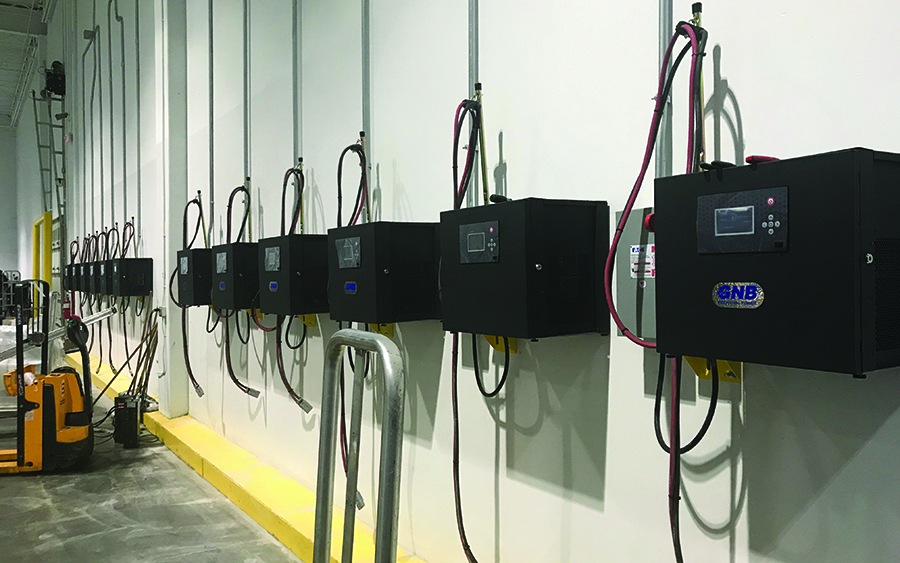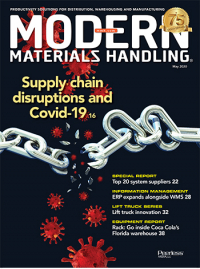Lift Truck Innovation: In Their Own Words
Modern talked to five leaders in the lift truck industry to find out what they expect the future will bring to the market.
 If you do a keyword search for the future of lift trucks, you’ll come up with these—automation, semi-automated, lithium-ion batteries, robotics and sealed lead acid batteries, to name five. And, if your initial reaction is that now is the time to look into these and related advanced technologies, you would be right on target.
If you do a keyword search for the future of lift trucks, you’ll come up with these—automation, semi-automated, lithium-ion batteries, robotics and sealed lead acid batteries, to name five. And, if your initial reaction is that now is the time to look into these and related advanced technologies, you would be right on target.
Lift truck fleets and their power sources are going to look quite different five years from now. That shift matters because it will mean to you higher operating efficiencies, a better match of trucks to the work at hand and a lower total cost of ownership. Here are what five leaders in the field say is coming your way in the very near future.
Director of global technology business development,
The traditional model is lift trucks that operators used to do work. Innovations included product design and features intended to help operators be more effective in doing that work. Now, the focus is on making the operator more productive by providing entire systems that do the work for you. Autonomous lift trucks are the central innovation here.
Critically important is that we aren’t talking about a single mode of operation. For warehouse managers, automation has always been an all-or-nothing proposition. But that’s not the case anymore. Dual mode lift trucks operate either with an operator or completely autonomously. This allows a phase-in of automation and/or the option to operate in a mixed environment that comes with the benefit of maximum flexibility. It creates a whole new operating arena in the warehouse.
Take a simple tow tractor. With dual mode automation, it can travel entirely by itself, making long runs and returns. It follows either a programmed path or uses 2D LIDAR guidance (also known as laser natural features) that sees the environment and adjusts its path as necessary. Or, if preferred in certain circumstances, an operator can manually operate that tow tractor and its train between pickup and drop off locations. It’s a true dual mode truck.
These are unlike traditional non-dual mode automatic guided vehicles that require specialized technicians to make any deviations to stopped vehicles due to dynamic conditions. Now, the typical warehouse worker with a standard operator license can be relied on to move vehicles, change their routes and destinations, and collaborate with other equipment. It’s a real game-changer, which is required for the full adoption of autonomous vehicles in warehouse environments.
How the truck operates is a matter of your preference given circumstances. But in every system, the three key operational factors are speed, path flexibility and safety. Combine those with nearly 100% reliability of all automated components, and you’ve got a system well suited to your specific operations and scalable to fit changing requirements without significant investments in creating or reconfiguring supporting infrastructure.
There’s also the matter of accountability. Too many automation projects get mired down in unproven technology and suppliers unable to deliver what was promised. And, that’s what happens before the system is ever up and running. Fortunately, that’s not the case with automated lift trucks. That might be the greatest innovation of all.

Senior director of marketing, motive power, Americas, Enersys
This is a time of great flux for lift truck power sources. While traditional flooded lead acid batteries now account for roughly 80% of the market, that is about to change. In five years, they will account for a minority of batteries sold. The dominant types of batteries will become lithium ion and sealed lead acid, also known as thin plate pure lead. Each of these two technologies account for less than 15% of battery sales right now. Meanwhile, hydrogen fuel cells will grow from less than 1% today to maybe 5% in five years.
This transition is a story of simplicity and ease. That’s what’s driving innovation. People are eager to minimize the time and effort needed to charge and maintain batteries. If they can get rid of the charging room altogether, they will. If they can do without the requirement for an eight-hour cooling cycle, they will. If they can do without having to own a second battery for every one in use, they will. All of those shifts will greatly reduce the total cost of ownership (TCO). The winner five years from now will be the technology with the lowest TCO.
The wild card in battery innovation, believe it or not, will be electric vehicles, whether it’s a Tesla or other brand. Lithium-ion batteries for lift trucks will ride on the coattails of what happens there. If the advances in car batteries is sufficient, it could make a stronger case for lithium ion to be the dominant technology, especially if TCO drops significantly. Either way, the convenience aspects of thin plate pure lead or lithium batteries will be what drives the change.
It’s worth noting that all battery technologies can be fast charged today. Interest here has really accelerated in the past couple of years. That will continue as users look for ways to keep trucks moving to meet ever-increasing demand for efficiency. Look for wireless inductive charging in particular to be in strong demand, too.
Vice president software solutions,
GNB Industrial Power, a division of Exide Technologies
We are living in the era of the battery. With significant advances in lead and lithium technologies, more options for electric forklift fleets are available than ever before. But making sense of this new world can be difficult. Advanced charging strategies combined with new battery offerings have made it nearly impossible to consider all of these choices, and yet it’s critical to do just that. End users and suppliers need to work together to tailor the power source based on requirements such as run time, energy throughput, lifetime, maintenance and cost performance.
Here’s an example of how this can work. As DCs have “gone vertical” adding more rack levels, reach trucks are challenged to lift loads higher. To do that, they burn energy faster, experiencing energy spikes that many batteries are not designed to handle. As a result, many are literally killing conventional lead acid batteries prematurely. Fortunately, there are two options here—air cooled lead acid or lithium-ion batteries. But how do you know which is a better solution for your specific application?
That’s where modeling software comes into the picture. This innovative approach does away with guessing and builds a profile of the suitability of potential power sources. The key modeling principle is to keep the vehicle running throughout the highest energy usage levels of the day while allocating the least time possible to recharge. But it doesn’t stop there. The models also seek to optimize battery use across its lifetime, providing the ideal cost of ownership.
It all starts with a power study that provides the data to model battery and charger options, and assign operational tolerances to these options. Power studies allow us to tailor solutions based on factors ranging from anticipated growth to potential missed charge time, making sure the system has the tolerances built in to satisfy the long-term needs of end users. Ultimately, it’s all about planning before a dollar is ever spent to ensure end users are happy with their motive power systems today and in the future.
General manager,
Jungheinrich Warehouse & Automation Products Group, North America
A very strong interest is out there to reduce labor costs, improve safety and enhance processes, and that is driving innovation right now. Each of those goals is increasingly achieved by bringing on fully automated and semi-automated lift trucks. Meanwhile, lithium-ion batteries are poised to significantly increase efficiencies, as well also enhance safety and processes in the world of power sources.
For automation, lasers and an array of sensors are the backbone of enabling automatic guided vehicles (AGVs) to travel safely. And 2D LIDAR navigation technology is adding an array of intelligence to allow lift trucks to navigate warehouses and distribution centers safely and expeditiously. Direct connections between the AGVs and warehouse management systems is further enhancing process improvement.
Automation does not have to be an on/off switch either. Options in semi-automated lift trucks and fully automated ones make the transition from manual operations easier to incorporate into a company’s workforce and culture, typically a phased-in approach over time.
Especially important here is the fact that these developments are being driven by end users and suppliers alike. There is such strong demand to make predictable and repeatable tasks an automated routine. The sweet spot for this innovation is labor tasks that people are actually better off not having to perform day in and day out.
That goes for the handling and charging of flooded lead acid batteries. Lithium-ion batteries do not require charging rooms or manual handling for replacement or recharging. That addresses both safety and process efficiencies.
Better yet, lithium ion requires only two or three hours to recharge, not eight hours as with flooded lead acid batteries. That not only eliminates the need for additional batteries for every truck over multiple shifts, but keeps more trucks running more of the time.
These are just some of the ways lift truck innovations are cost effective and employee friendly. As companies evaluate their options for their business, they will discover still other reasons to adopt these new technologies.
Emerging technology commercialization manager,
Yale Materials Handling Corporation
We see innovation in lift trucks focused on three areas: telematics, robotics and motive power. With all three, end users have more options than ever. And just as important, each of those innovation centers are focused on making truck operation as smart as possible.
Telematics collect and share truck data, providing not just an operational baseline, but insights into efficiencies. This allows companies to put the right equipment out on the floor at the right time to manage the work that needs to be done right then. Telematics also ensure that the right number of lift truck operators are available and operational on an as-needed basis.
Robotics is a really interesting development. Robotic lift trucks offer the flexibility to move loads with and without an operator. No other autonomous transport technology—automatic guided vehicles or autonomous mobile robots—can do both. That gives robotic lift trucks a huge advantage, depending on circumstances, in the horizontal and vertical movement of loads. They can also be linked or not to warehouse management and warehouse execution systems, providing still greater flexibility than other technologies. It all comes down to making robotics operation as smart as is necessary for the application rather than having to adapt the application to the technology.
Motive power is all about finding the right power source for the application. The objective is a combination of the lowest total cost of ownership and fulfilling the end user’s needs. Lead acid, hydrogen and lithium ion each have their strengths. The goal is to match the technology to the need for speed, throughput, long runs or what have you. Never before have there been so many options to match motive power to the lift truck operation.
In the end, innovation has made lift trucks much more than a fork and a steering wheel. With innovation, lift trucks are mobile data collection devices and robotics platforms with the versatility to match motive power to operational needs.

Article Topics
Lift Trucks News & Resources
BSLBATT is looking for new distributors and resellers worldwide Hyster recognizes Dealers of Distinction for 2023 Carolina Handling names Joe Perkins as COO Toyota Material Handling North America appoints Mark Taggart as CFO Learn from lift truck service history Toyota Material Handling honors its top forklift dealers in North America Fleet Team expands with strategic acquisition of Forklift Training Systems More Lift TrucksLatest in Materials Handling
Registration open for Pack Expo International 2024 Walmart chooses Swisslog AS/RS and software for third milk processing facility NetLogistik partners with Vuzix subsidiary Moviynt to offer mobility solutions for warehouses Materials Handling Robotics: The new world of heterogeneous robotic integration BSLBATT is looking for new distributors and resellers worldwide Lucas Watson appointed CSO for Körber’s Parcel Logistics business in North America Hyster recognizes Dealers of Distinction for 2023 More Materials HandlingSubscribe to Materials Handling Magazine

Find out what the world's most innovative companies are doing to improve productivity in their plants and distribution centers.
Start your FREE subscription today.
April 2024 Modern Materials Handling

Latest Resources

















